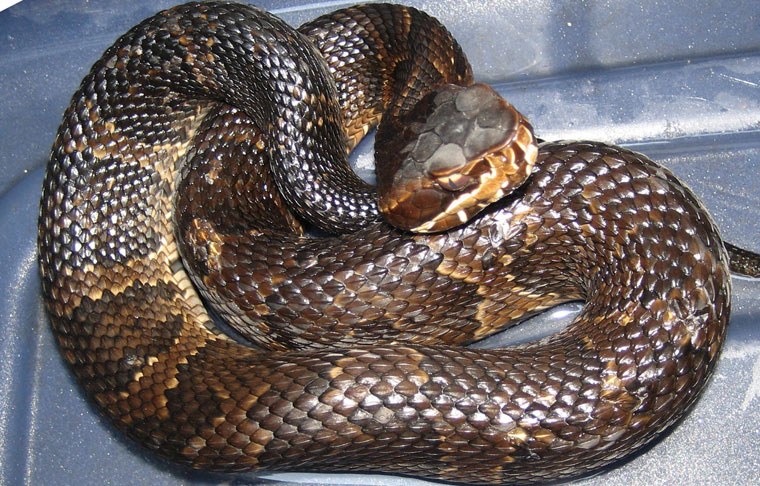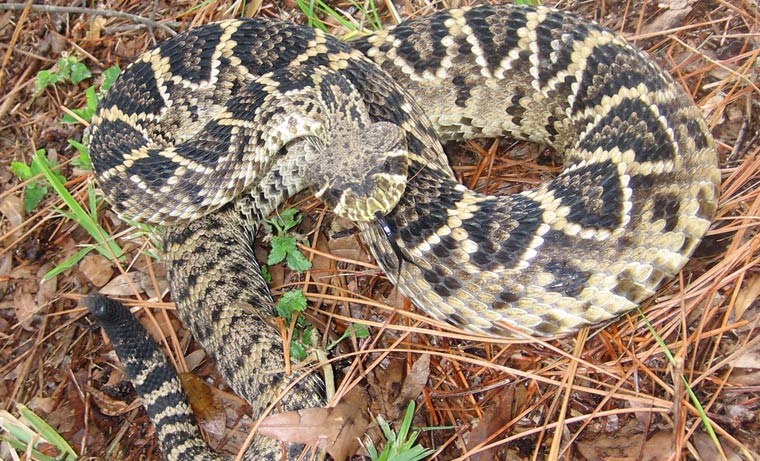-
info@aaanimalcontrol.com
Call us for help in your town
Humane Wildlife Education
Venomous Snakes of Florida
Need snake removal in your hometown? We service over 500 USA locations! Click here to hire us in your town and check prices- updated for year 2020.
Did you know that there were over 50 recorded snake species found in Florida? Don't worry, that statistic makes things sound a lot worse than they actually are. Out of that 50-something snake species found in the State, only a handful of them are actually considered to be dangerous to humans, pets and other animals. Six, to be exact.

Snakes are actually very beneficial to the local ecosystem that you live in. To start with, most snakes eat mice, rats and other rodents, and when snakes are eating these critters, they aren't invading your homes. They also help to keep the populations of other animals and insects down, and for that we should probably thank them. If you've ever sat outside at sunset during the summer you'll have a good understanding for just how annoying those insects can be, especially once they start biting your skin. That's before we get into how bad it is to have rats and mice anywhere near your home. We're sure you know that stuff already.
The Six Venomous Snakes of Florida
We don't think that 6 venomous species and 44 non-venomous species is too bad a ratio, but one of the things that can make the venomous snakes somewhat more dangerous is that some of the non-venomous ones have actually started copying their colorations and patterns. This means that you could be up against a venomous snake believing it is a non-venomous one, or vice versa. It's probably not the kind of situation you would want to find yourself in. Do you know the difference between venomous and non-venomous snakes? Would you know how to tell the difference even if you were to find yourself close enough?
The 6 venomous snakes of Florida are:
Eastern coral snake, also known as the coral snake
Dusky pygmy rattlesnake, also known as the ground rattler or pygmy (/pigmy) rattler
Canebrake rattlesnake, also known as the timber rattlesnake
Eastern diamondback rattlesnake, also known as the rattler or generic rattlesnake
Florida cottonmouth, also known as the cottonmouth or water moccasin
Southern copperhead, also known as the highland moccasin, chunkhead or copperhead
What to do if you come across a snake in Florida:
Firstly, leave it alone. Do you know what species of snake it is? Do you absolutely know for sure that the snake you're looking at isn't a venomous snake? Some of those venomous snakes can pack a powerful punch with some potent venom. Running the risk of being bitten by one of them, and having that venom injected into your bloodstream, really isn't worth it. There are professionals that approach these jobs with caution, and that means you definitely should.
Most snakes that you come across are non-aggressive unless they have a reason to be aggressive. If you leave them alone, they'll generally leave you alone. If you get too close, they'll slither away. Most of them don't want to fight you. You are a much bigger predator than they are, and they know they often won't win in a fight. This doesn't mean they won't try though, particularly if they are a venomous species.
Snakebites are quite a rare occurrence, and the majority of them happen when humans are trying to handle the snake. The snake isn't really aware that the human is trying to save it — capture it and then release it somewhere in the wild again. Instead, the snake just thinks that the human is another predator, out to get it. It will react in the only way it knows how — defending itself with whatever form of attack it can throw at you. That's why you should leave snakes in Florida alone. Most of them have absolutely no intentions of coming anywhere near you. The ones that do encroach on your land will have done so for food, water, or perhaps just to bask in the sunlight. Some snakes are known to get a bit annoyed if you try to disturb them from their sunny spot, so you must also bear that in mind.
Even dead snakes are not a good thing. All snakes can have somebody reflexes after they have been killed, and it is not unheard of for convulsing, dead snakes to snap their jaws shut, and also release whatever venom they have in their stores. You wouldn't want to be bitten by a dead snake, venomous or otherwise, any more than you would want to be bitten by a live one.
How to tell if a snake is venomous or not?
There is no easy way to tell whether or not a snake is venomous, because there are some species of snake that will mimic the coloring and actions of more dangerous species in order to fool predators. Let's say that the snake you can see is striped, however. If the scales of that striped snake are smooth, it could be a rainbow snake, particularly if the back of the serpent is a glossy black, with 3 red stripes, with or without black spots. If the belly is brown, orange or a yellow shade, it could be a common rat snake. Dark brown with lighter brown stripes would usually indicate a striped crayfish snake. All of the snakes we have mentioned so far are non-venomous.
If the snake does not have stripes, but has more of a blotchy appearance, you could be looking at an Eastern corn snake, a very docile species. In fact, the corn snake is commonly referred to as a beginner's species in the world of exotic pets. If the snake has an upturned nose and blotches, however, and even more so if it flattens it head when you approach, you could be looking at an Eastern hognose snake. Once again, you are looking at relatively harmless and non-venomous animals.
Venomous snakes tend to be rather brightly colored, or with a large rattle in their tail, although, as we've discussed, appearances can often be deceiving. If you live in Florida and keep finding yourself coming up against snakes, it might be worth your while to spend a little time investigating what the common species look like, or at least have some idea of what the most dangerous and venomous ones look like. You can definitely avoid them if you know they're in front of you!
Venomous snakes of Florida
Need snake removal in your hometown? We service over 500 USA locations! Click here to hire us in your town and check prices- updated for year 2020.
There are many places across the United States where you are able to find venomous snakes, and Florida is no exception to this. In fact, because of its climate and ecosystems, many of the more poisonous of the species find themselves right at home within the swamps, lakes, and other areas of the state. It is definitely a perfect location for a venomous snake to find a home.

For those living in the state, they probably don't want to hear about how exceptional of the location it is for these creatures, but there really isn't very much they can do about it. Venomous snakes are thriving in the state, and here are some of the most common that you will find.
The eastern coral snake - this is a snake that is very easy to be able to identify. It comes with alternating darkish red, yellow, and black stripes that circle around the snake. What you will find is that the red and black stripes are about equal in size and reach to about one to two inches in length, was smaller yellow circles alternating between them. This gives it a very unique look that is easily distinguishable.
You should be aware that the venom of this snake is a form of neurotoxin, which means that it directly attacks the nervous system of your body. If you are bitten by one of the snakes, it will not be long before your diaphragm will shut down and you will be unable to breathe. Getting treatment right away is absolutely essential.
The Florida cottonmouth - this is also known as a water moccasin, and is a very dangerous animal to come across. While having patterns that go across the snake, what you will notice is that the vast majority of the visible exterior of this animal is blackened. There is also a black line that runs down the snake's head from its nose, through the eye, and to the back of the head region. Even babies of this species of snake will have the black line on the side of its head.
The dusky pygmy rattlesnake - reaching anywhere from 15 to 22 inches long, this snake is quite easy to identify should you come across it. It starts with the small rattle on its tail that makes us sound that is similar to a group of insects buzzing. If you look at the exterior of the snake, you will notice black almost oval like patches that go down the center of its back and are also located on the sides. If it makes you feel any better, being bitten by the snake is not fatal, but it will hurt a lot.
The eastern diamondback rattlesnake - of all the venomous snakes in the United States, this is the largest of them all, reaching to his size of up to 6 feet long. It is known to sit in a coiled position, which allows it to lash out at animals and other creatures that come across it. A bite from this animal is extremely dangerous.
For more information, you may want to click on one of these guides that I wrote:
How much does snake removal cost? - get the lowdown on prices.
How to get rid of snakes - my main snake removal info guide.
Example snake trapping photographs - get do-it-yourself ideas.
Snake job blog - learn from great examples of snake jobs I've done.


















